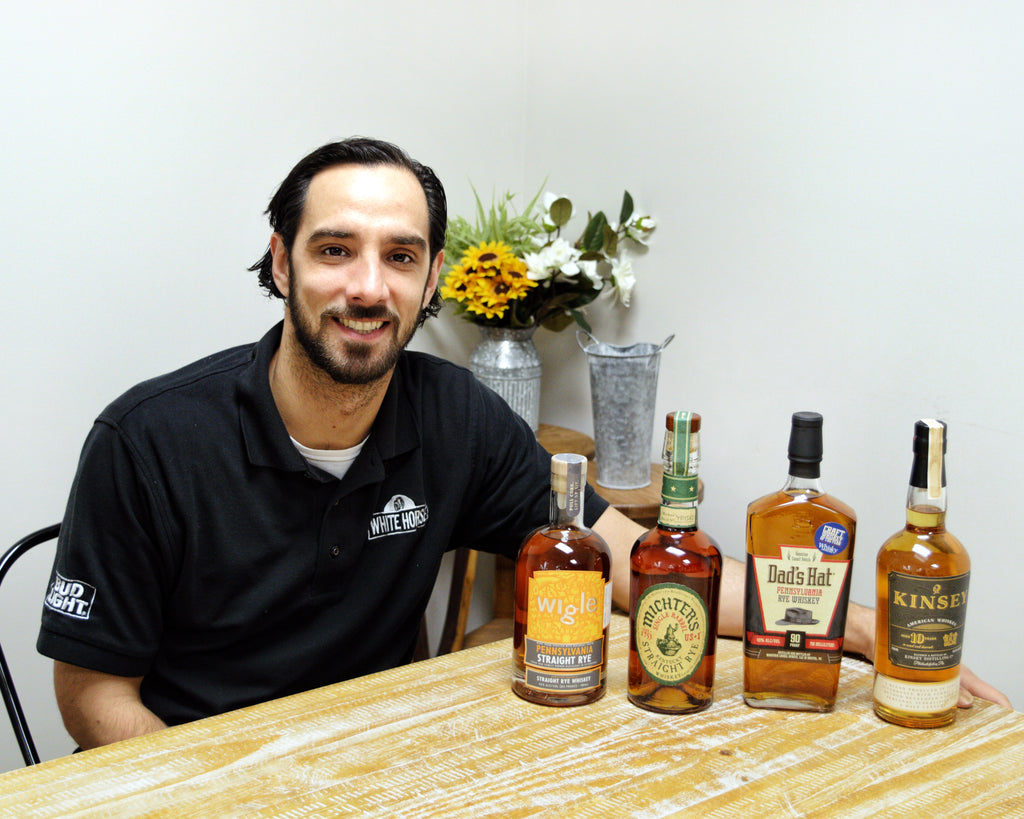When you think of whiskey, you probably think Tennessee or Kentucky, but the story of American Whiskey actually began right in our backyard in Pennsylvania—long before bourbon was ever a thing.
The Beginning
It all began with the settling of Scots-Irish and German farmers in the 17th century. These farmers planted rye seeds, which thrived in Pennsylvania’s rocky soils. They would often find themselves with a surplus of the grain, and back then, nothing went to waste! First, they used the grain to make beer. But in pre-pasteurization days, beer didn’t keep too long, so they brewed only as much beer as would be consumed in the very near future. Any grain leftover after beer making was used to make whiskey, which was much more difficult and dangerous to make (think: flammable liquids near open flames).
The Whiskey Rebellion
If you don’t remember learning about the Whiskey Rebellion in history class, here’s a quick refresh: many states were in debt following the Revolutionary War, and in 1790 Alexander Hamilton pushed for the federal government to absorb the debt and pay for it with an excise tax on whiskey. This would be the first excise tax in U.S. history.
President George Washington, while initially opposed to the tax, journeyed through VA and PA to speak to citizens about their views. Local government officials met the idea with enthusiasm, and Congress passed the bill — but small distillers, who couldn’t take advantage of the same volume discounts on the tax that larger producers could, immediately protested.
Under the new law, large producers paid the tax annually at a rate of six cents per gallon. The more they produced, the better the tax breaks. Small producers, however, were stuck paying nine cents per gallon.
Farmers took further issue with the tax because only cash would be accepted for payment. Why was that a problem? These guys didn’t have any cash. They might have been making a decent living, but most transactions at that time were still conducted by barter.
Producers across the nation showed their dissatisfaction with the tax in their own ways, but nowhere did the anger turn into violent revolution as universally as in Pennsylvania. Aside from having no cash, the distillers in western Pennsylvania were expected to make their way to Philadelphia, which was a couple of hundred miles away, when summoned to court to answer their charges.
In response, many distillers simply didn’t pay the tax. Two of these rebel distillers—John Mitchell and Philip Wigle—were found guilty of treason and sentenced to death. Both were later pardoned by Washington, however.
Pennsylvania tax collectors had their work cut out of them. They were threatened, assaulted, and even tarred and feathered. In 1794, a mob of 700 men attacked a wealthy landowner and tax collector. Washington marched from the capitol in Philadelphia to Pittsburgh with 13,000 troops to shut down the rebellion—the first time in American history a President marshaled troops against U.S. citizens.
The whiskey tax that inspired the rebellion remained in effect until 1802. Under the leadership of President Thomas Jefferson, the tax was repealed after continuing to be almost impossible to collect. But it was almost too late for Pennsylvania Rye. Many PA distillers relocated to Kentucky, and Prohibition nearly wiped out all that remained.
Today
Lucky for us, Pennsylvania eased its distillery regulations in 2011, and new PA whiskey—including rye—is beginning to trickle out. Several other distilleries with ties to the Whiskey Rebellion are also paying homage to their PA roots.
Here are four great whiskeys you can drink right now that give a nod to Pennsylvania’s rich whiskey history:
Michter’s Single Barrel Straight Rye
 Originally known as Shenk's and later as Bomberger's, the whiskey company that ultimately became known as Michter's was founded by John Shenk, a Swiss Mennonite farmer, in Schaefferstown, Pennsylvania in 1753.
Originally known as Shenk's and later as Bomberger's, the whiskey company that ultimately became known as Michter's was founded by John Shenk, a Swiss Mennonite farmer, in Schaefferstown, Pennsylvania in 1753.
According to Pennsylvania historical folklore, this particular rye whiskey was so valued that when the Revolutionary War broke out, General George Washington visited the distillery and purchased whiskey to fortify his men as they hunkered down through the long, brutal winter. Some would say Michter's was "the whiskey that warmed the American Revolution."
In the mid-1800s, Pennsylvania Dutchman Abraham Bomberger purchased the distillery and it became known for many decades as Bomberger's. The passage of Prohibition in 1919 forced the distiller to shut its doors to the public. Although the distillery reopened after the repeal of Prohibition, it changed hands many times over the next few decades.
During the 1950s, Lou Forman, one of the distillery's then-owners, created the modern Michter's brand name by combining portions of his sons' names - Michael and Peter. In 1989, Michter's then-owners declared bankruptcy and abandoned the premises, leaving its Pennsylvania operations in disrepair and the Michter's name seemingly lost to history.
In the 1990s, Joseph J. Magliocco and his consultant and mentor Richard "Dick" Newman teamed up to resurrect Michter's. Magliocco and Newman began with a simple strategy: honor the Michter's legacy by producing the best whiskey possible. Their first major strategic decision was to resurrect Michter's in Kentucky, in the heart of the modern American whiskey industry, to ensure access to the best whiskey talent and resources available.
Although the company is now located in Kentucky, they’ve stayed true to their PA roots--especially with Michter’s Straight Rye. Each batch is made in a single barrel, so your experience might be a bit different, but generally, you can expect spicy rye notes mixed with butterscotch and candy corn.
Dad’s Hat Pennsylvania Rye Whiskey
 This is a pure expression of Pennsylvania Rye Whiskey. This small-batch whiskey is barrel-aged for at least six months in charred, new oak quarter casks. It delivers the up-front spice that rye is known for with underlying notes of dried fruit and black cherry with hints of tobacco, vanilla, and oak. It finishes smooth with a full, round mouthfeel.
This is a pure expression of Pennsylvania Rye Whiskey. This small-batch whiskey is barrel-aged for at least six months in charred, new oak quarter casks. It delivers the up-front spice that rye is known for with underlying notes of dried fruit and black cherry with hints of tobacco, vanilla, and oak. It finishes smooth with a full, round mouthfeel.
Wigle Organic Small Cask Rye Whiskey
 Wigle, the first distillery in Pittsburgh since Prohibition, opened its doors in 2012. The owners named the distillery after Phillip Wigle, one of the rebel distillers who was convicted of treason during the Whiskey Rebellion. The company has an ambitious production schedule that runs more like a brewery than a distillery, with a portfolio of 30-plus products that range from sensational, award-winning bonded rye and all-wheat whiskey to an inland take on America’s original spirit: rum, which is made with local buckwheat honey.
Wigle, the first distillery in Pittsburgh since Prohibition, opened its doors in 2012. The owners named the distillery after Phillip Wigle, one of the rebel distillers who was convicted of treason during the Whiskey Rebellion. The company has an ambitious production schedule that runs more like a brewery than a distillery, with a portfolio of 30-plus products that range from sensational, award-winning bonded rye and all-wheat whiskey to an inland take on America’s original spirit: rum, which is made with local buckwheat honey.
Wigle Rye offers notes of vanilla on the nose, but the taste comes across as floral, which mixes nicely with the characteristic spiciness of the rye.
New Liberty Distillery Kinsey American Whiskey
 Kinsey was born in Pennsylvania in the 19th century, and Kinsey American is an homage to the distillery's original location along the Schuylkill River. This 10-year whiskey was blended to replicate the flavor profile of a 1940/50s sample of Kinsey and was made from 100% corn and aged in oak. It’s not a Rye like the other whiskeys on our list, but it’s still distinctly Pennsylvanian.
Kinsey was born in Pennsylvania in the 19th century, and Kinsey American is an homage to the distillery's original location along the Schuylkill River. This 10-year whiskey was blended to replicate the flavor profile of a 1940/50s sample of Kinsey and was made from 100% corn and aged in oak. It’s not a Rye like the other whiskeys on our list, but it’s still distinctly Pennsylvanian.
Kinsey American opens bright and vibrant on the palate, leading to floral, semi-sweet vanilla notes and finishing with hints of honeycomb and caramel corn.
Cheers!

